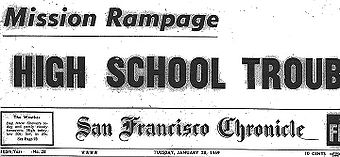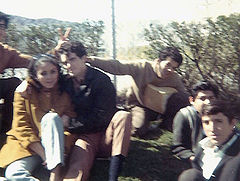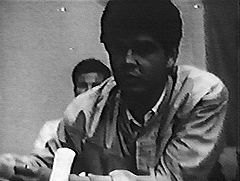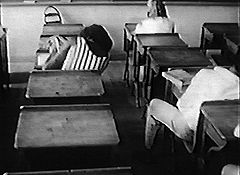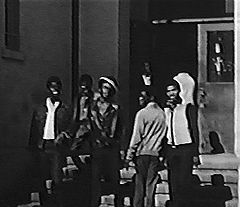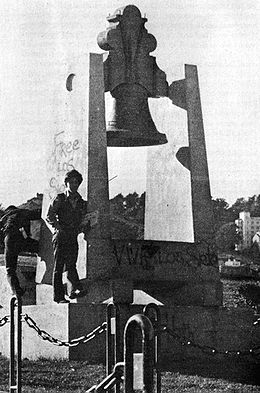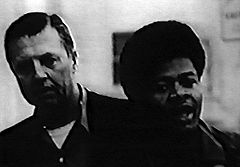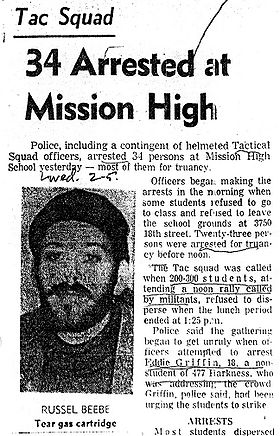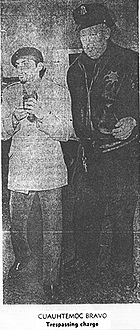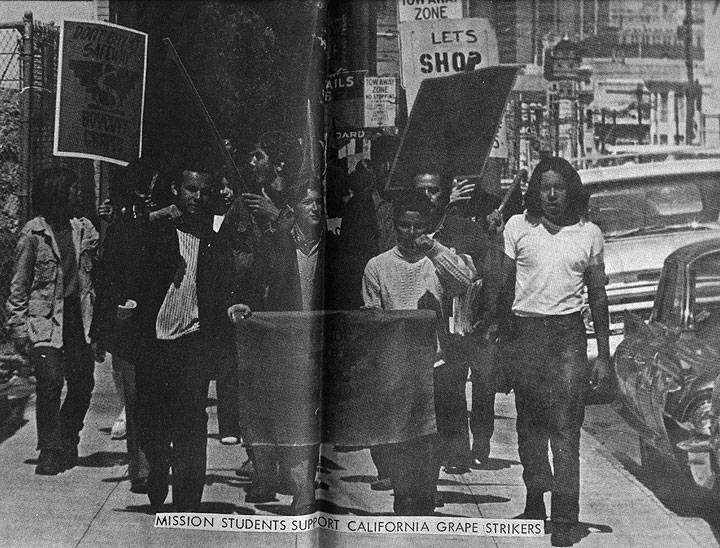Mission High School Student Organizing 1969
"I was there..."
By Francisco FloresLanda
No Smoking in the Principal’s Office!
On January 28, 1969 the SF Chronicle headline screamed “Mission Rampage: High School Trouble.” On February 6 they declared “Thirty Four Arrested at Mission High.” Before these incidents on January 24 two reports were issued dealing with the crisis’ in the schools; one by the Council of Civic Unity, a conservative civic group, the other by the SF Human Rights Commission a quasi-government entity. Both called for reforms at the high schools. For us, a group of Mission students, the story began some time before. We put forth a different but similar solution, not fully thought out but it came from the base—the students. I can peg that fateful beginning to the morning I met Neftali.
One morning during gym class fate lined me up next to Neftali. Our conversation turned to the Mexican and Mexican American experience; if you can believe seventeen year olds discussing serious politics! The conclusion of the conversation was to do something—to organize. Serious political discussions among the youth were a sign of the times. We saw the need to do something at Mission. Neftali had his friends and supporters, Fausto and others. On my side Diana Monge, Martin Ordenana, Oscar Coronado, and Joaquin were ready to jump to action. Other sympathizers will remain unnamed.
We Did Not Falter
One of our first acts was going to the Spanish student club to present our ideas. To my amazement and disappointment the group would have none of it; we were turned down. When I became politically aware I thought everyone would join this important stuff. We were naïve. We did not falter.
The club was a traditional and conservative ‘Spanish’ (not Latino) social and cultural student group, mainly about tacos, tostadas, the jarabe tapatio and other traditional cultural stuff. Stuff which is fine but did not rise to the moment, it missed the mark of changing the socioeconomic conditions; of dealing with the status quo that Latinos and other ethnicities lived and continue to live under; of high dropout rates, discrimination, alienation, and things of this nature. The sponsor was Mrs. Buchard, a conservative Latina teacher. She didn’t agree with us and never did. I recall the usual conservative judgments; we were too young, we didn’t know what we were talking about, it was a waste of time, we’re being duped by outside agitators. Another teacher, Mrs. Barranco, a Panamanian, was very much on board in the background.
Marta Estrella in an interview on July 2 2011 claims she did not relate to the Latino student group because she was ‘Chicana.’ Her circle knew her as a “sandal wearing hippie” not the social make-up of the club. This is significant because it displays the layers of acculturation in the Latino community, the Latino club was made up of recent immigrants, she belonged to the “other” or the native-born, second and third generation people who adopt new cultural forms different from the first generation immigrants who reject acculturated Latinos believing they are traitors or that they are ashamed of being Latino. Even though there is some element of shame because of internalized racism shaming is not the general rule for their acculturation. They have simply passed through a process of transacculturation where a process of transference of cultural forms has occurred.
As a result of that the rejection we formed an ad hoc group and came up with four demands; relevant education, Latino history classes, Latino teachers, last but not least Latino food in the cafeteria. We should have stuck to these original demands. Our idea was making the school a welcoming inclusive place where students feel good.
Background
For Mrs. Barranco’s US History class I had written a report on Mexican American history and the social conditions Mexican descent people and other Latinos face in the US. She used it as teaching material in her classes I found out she was using it as text when Rafael Betancourt, may he rest in peace, asked me if I had written the paper. That was how I heard that Barranco was using it as class material. That felt good. I was unaware of how that paper would set me up as a student leader.
I was so motivated that I dropped some bennies and stayed up all night to work. I didn’t have proper research and writing training; but I did the best I could, I researched various sources, the census, the Economic Opportunity Council (EOC), which had offices on Valencia @ 19th St., the EOC was part of President Johnson’s War on Poverty, I borrowed heavily from North from Mexico by Carey McWilliams, I used student demographic information from the SF Unified School District. Back in the day, circa 1968, there was a dearth of written material about Latinos and their issues, probably that is why Barranco used my research paper, and I had put a local bend on it. One fact of the report that impressed me was the high dropout rate of the Latinos and African American students at Mission and throughout SF. This continues to be the case if not worse.
In another class assignment, to respond to a question about inspiration or contemporary sympathies, I responded that I sympathized with the Students for a Democratic Society (SDS). The surprised teacher pulled me aside to ask me the why of my answer. I had seen news reports on the television newscasts about the SDS and what they were doing at UC Berkeley I must have been 14 or 15 years old. I sympathized out of carnal instinct it certainly wasn’t out of intellectual knowledge. Back then sympathizing with the SDS was like saying I sympathized with the devil, SDS was the most radical white political development to date.
Those days were not ‘regular’ days. The days of 1969 were days of a worldwide student movement as well of worldwide national liberation movements; Vietnam and Asia, Africa and Latin America were in rebellion against the North American and European neo-colonialism. In the US, the civil rights movement was in full swing, African Americans, Mexican Americans, students; the young as well as the multinational working class were making demands for change. Locally, the San Francisco State college strike was on. In the Mission District, the war on poverty was also alive (government and private agencies attempts to deal with poverty were more at attempts to misdirect the progressive and revolutionary forces); also the EOC and Horizons Unlimited, Youth for Service, Mission Rebels and Arriba Juntos were a reflection of its presence in the community. At the time I was unaware of how it all fit together. Independent non-dependent political groups were scarce, social service agencies mostly strived for money—until the Committee to Defend Los Siete de la Raza began denouncing the sellout agencies. And around this time a multitude of grass roots ad-hoc committees appeared across the Mission District landscape; youth, student, workers in SFGH and the Laborers Local 261, welfare moms, environmental groups, food coops like Rainbow Grocery, and more.
In my quest for enlightenment, very significant for me, was the United Farmworkers Union (UFW). The UFW embodied the closest thing to an independent Chicano movement but it was only one part of it. The Union was at the height of the grape boycott to gain union recognition as well as a labor contract for the mostly Mexican descent farmworkers. I supported the UFW passionately, my father had been a farmworker, Delano and the San Joaquin Valley raised romantic notions since I wasn’t too far removed—timewise, socially, historically, and personally from being there. That was something that was very much alive for me. The image of Mexicans stooped in the fields burned in my chest with the recognition of the exploitation we, my people, were experiencing.
The brown beret, the red bandana, the khaki shirts (I would sometimes wear a sarape) and such symbols excited my ethnic identity and pride. The Brown Berets organization had echoes locally, some people attempted to organize a chapter based at the Good Samaritan on Potrero Avenue; Roberto Vargas, Ricardo Carrillo, Johnny Rodriquez, Jesse and others tried to form a chapter. During my early awakening I was unaware of Corky Gonzalez’ Crusade for Justice in Denver; of Lopez Tijerina and the assault on the courthouse in New Mexico seeking recognition of the 1848 Land Grants. I was ignorant as well of white working class struggles for union recognition, for union contracts, for the eight hour day and other reivindications.
Stirrings
A good friend, Domingo Prado Leon, may he rest in peace, and I at one point discussed organizing. Our plan was for him to organize at Gompers High School at 22nd & Bartlett; we thought that we would organize all high schools. Him at Gompers, me at Mission, and expand to the rest. His political awareness came from the fact that as a Nicaraguense, his country had been invaded by the US multiple times, his nationalism was ardent. That, as well as that his brother was in the FSLN in Nicaragua, a clandestine movement working for the overthrow of US supported and puppet the Somoza Dictatorship. Observe how the world is linked, one thing in one place may affect something else far away.
Domingo and I were the first ones to organize publicly in support of the FSLN in SF albeit only once. In 1970, we organized a film showing to raise money to conduct a “revolutionary” activity. We planned to carry out the kidnapping of the Nicaraguan Council in San Francisco. Besides the action being a blow to the Somoza dictatorship we were going to call for his brother’s release from Somoza’s prisons. This didn’t happen, my girlfriend Nilda thought it a crazy scheme, and she didn’t support me on this one. Domingo lacked the discipline and the ability to work in a collective fashion. He was very rough around the edges. Good thing . . .. With the money we raised he bought a Jeep and a shotgun, Army style clothing and proceeded to ride around the Mission District with the Jeep full of Latino kids pretending to be and looking like they were guerrilleros—Fidel Castro style, cap and all and smoking a cigar.
The following is from the Movement Newspaper of March, 1969.
“Mission High School has about 2050 students: 450 blacks, 680 Whites, 750 Latinos, and 75 Chinese. Its students came from families with the lowest incomes in the city, averaging $5300 per family. The Latinos are the poorest of the ethnic groups, averaging some $3500 per family. The unemployment rate for male Spanish-speaking residents of the Mission is as high as 18% . . .. Thirty-nine percent of the students at Mission are bi-lingual; that is, they have learned, or are now learning, English as a second language. There are no programs at Mission to help these students outside of standard remedial language instruction . . .. The number of students at Mission has declined by 200 every year for the past three years, as the drop-out rate has exceeded 1/3 of all the students enrolled. Out of the 2050 students, between 450 and 600 are absent daily that is approximately 25% or ¼ of the student body. The average student at Mission is absent 82 days out of the school year.”
The situation at the school seemed to be pretty serious we had a high dropout rate but this was not something that one could see in the school environment. Years later I went into the school to look at the graduation pictures that hang in the main hallway, to my surprise, in the year of my graduating class or the years before or after I did not see anyone I knew.
I recently saw a motion picture, in the Los Siete de La Raza film, of a classroom at Mission with only a few students in class, and the ones there had their heads on the desktops sleeping. I recall that on Fridays after lunch the hallways seem like a party scene with a lot of kids high on drugs partying. The hall guards would be very busy chasing kids around asking them for their hall passes. Frequently we would run away from them and they would chase us.
Marta Estrella, in our interview of July 3, 2011, remembers a lot of aggression in the hallways on the part of some black students, she feared walking past the aggressive black students especially at the bottle neck crossroads in the second floor stairway; she avoided those areas where the aggressive black students congregated. For herself she sought safety among her Samoan connections (Samoans were physically large people everybody respected). She as a friend received their protection.
She also complains that textbooks did not have real history. This was one of our demands; Lation@ history classes. She also recalls that the teachers were white. Another demand was for more Latino teachers, persons that Latinos can relate to, whites ten to be racist. To the credit of one young white woman teacher Marta explains would have meaningful discussions in the class. During one such discussion Marta was attacked verbally by black female students because she mentioned slavery in class. In my experience, African Americans resent the fact that blacks are talked about in schools only, many times, within the context of slavery and depicted as savages.
The Movement newspaper spelled out the social role of the educational system as being a place to produce low wage workers for the local businesses and factories leaving the students with little hope. It explained, “. . . the corporate control comes by way of the SF Industrial Education Council, a branch of the National Alliance for Businessmen, locally coordinating the educational interest of PT&T, Pacific Gas & Electric, Southern Pacific and Lockheed, among others.”
The Spark on Thursday and Friday Jan 23-24, 1969
When we began our organizing at Mission we came up with four demands. We wanted Latino teachers, relevant education, Latino history, and last but not least, Latino food in the cafeteria. After the presentation to the Latino club, events rapidly and unexpectedly exploded beyond our control. Elements that pushed their own agenda surfaced. The spark that forced our hand was a fight with some African American students when they came to attack my friend Edy Morales. Edy had had a confrontation with one of them during the lunch period in the cafeteria. As we sat at our usual lunch spot at a stairway—Edgar Morales, Enrique Menjivar (RIP), and other friends from Folsom Playground and La Veinte, fifteen black guys came from the cafeteria to “kick his ass.” ([[|A detailed explanation of the events of the fight and subsequent race riot turned political struggle.)
Three of the blacks were brothers; the middle brother chose to fight Edy instead of the younger one who had the encounter with him in the cafe. Edgar, Edy’s older brother, seeing an unfair match-up, jumped in saying, “No, I’ll fight you.” Then the oldest of the three declared, “I’ll fight you” to Edgar. At this point Henry Menjivar yelled out in Spanish to us, “Que es esta mierda a darles en la madre” -- “What is this shit lets beat their ass.” We jumped out at them since we were holed up in the stairs, to me it was the best tactic, all the blacks tried to get at us, but since only one or two could come up the doorway and stairs, we beat them back. Immediately a whole lot of Latinos came over to help us, astutely the blacks ran to safety among their own by the girl’s gym on 18th street. The other black students out at lunch began lining up with them on the sidewalk. The Latinos lined up across the street facing the blacks; before the punches could begin the police interceded. At one point, the ‘white shoes’ came to offer and swear allegiance to us and to help us. The white shoes were white boys and gringo-ized Latinos. The term white-shoes originally referred to boys going to catholic school wearing a certain type of two tone shoes as part of their uniform—hence white shoe. Oral history holds that when bards, urban-like Latinos and whiteshoes ran into each other they would fight each other.
Trouble occurred in other areas of the school grounds; Martha Estrella explained that she and a friend, Iris, chose to go up on the hill behind the tennis courts in Dolores Park to see the action. As they stood up there watching the two sides some African American students came up on their flanks cursing at them with one throwing a bottle at them. They became “very scared.” She remembers a lot of cursing along with the aggression.
In the school, the teachers locked the doors to their classrooms. The next day everyone expected trouble. There was a heavy police presence so the fighting didn’t come to fruition. But there was some generalized aggression—roaming the hallways, vandalism, and trashcans set on fire in the bathrooms.
Over the weekend, a parent group calling itself Mission High Parents Group wrote (Examiner Jan. 26, 1969 pg. 1) the Chief of Police Cahill asking for more police presence at the school. The letter said, “We would like protection against (1) students who refuse to go to class, who constantly create disorders through intimidation and bodily harm to their fellow students and teachers; and (2) the outside element.” One reason for the request according to the article was that “more than a dozen black and Mexican–American students staged a demonstration that left Principal Harry Krytzer office in a shambles.” We had a meeting in the principal’s office from which we militantly stormed out. The request for extra cops was turned down because the chief said the department was understaffed.
Outside Support
Significantly, student strikers from San Francisco State College and others from community organizations came to support us; one of their immediate concerns was that Latinos and African Americans should not be fighting; another concern was support for our grievances. Al Martinet, Jimmy Queen, Ricardo Laraniaga not from State, and some from Horizons Unlimited—Roberto Vargas, Ricardo Carrillo and others came to Mission. The most was-to-become famous was unknown to me—Marylyn Buck who volunteered with Newsreel, a radical film distribution and production group, she later was to become spokesperson for the Weather Underground, a really extreme radical leftist group. Roberto Vargas also became well known. Some Black people, Panthers among them, also came to work with the black students. Another supporter Doug Norberg had a place where we met; he also owned a Gestetner mimeographing machine where we produced some of the leaflets we passed out during our organizing. Some of the grownups from State were political radical revolutionaries and they emphasized that Black and Latino peoples had a common enemy, the capitalist system not white working class people, and should unite and not fight each other.
There were commotions over several days, at one point Rafael Betancourt, was put in a police car. When the guys and girls from the 26th Street and the Lucky Alley boys saw this they gathered and angrily marched toward the squad car when the cops saw them coming they let him out of the car and drove away!
Peace
Peace talks were begun by the Latino community leaders, the school, and the police. They proposed that two students one Latino and one black, duke it out to settle the interethnic conflict. I, like a fool, let myself be taken to fight the one black selected. We were taken to Diamond Heights right over Clipper St. to fight. He wasn’t much of a fighter neither was I, we wound up entangled wrapped up around each other all tired out before the stupid fight was stopped.
We returned to the school supposedly having achieved peace. To the day I feel foolish for having let myself be dragged into that episode. Nevertheless the guy and I wound up being friends afterwards, I saw him for years after always being cordial with each other. Edgar Morales explained that if this would happen today, having students go fight to resolve conflicts, someone would be fired. This speaks to the incompetence of the school district.
After the initial conflict we united with the African American students; the most vocal and willing to unite was a girl leader named Gilda. We formed a united front of black and brown students. As part of the united front we developed a joint list of seventeen “unconditional” demands. After we merged the blacks grievances with ours they became ‘unconditional’ during the aforementioned meeting in the principal’s office to discuss what we wanted a black student blurted out “unconditional,” so the demands became unconditional. When we presented the demands to the principal in his office one of the students began smoking cigarettes, I believe it was Oscar Coronado, others followed suit. The principal was stumped; he was afraid and couldn’t respond to students negotiating in his office and smoking. After a while he got enough courage to announce that there was “no smoking in the principal’s office.”
No Smoking in the Principal’s Office
When Neftali saw that we were involved with the black students, he and his group dropped out of the organizing effort—then as now there existed a lot of interethnic conflict.
On Wednesday January 29 1969 we were arrested for leafleting at the school. The next day according to the SF Chronicle reported two non-students and one high school student had been arrested as they passed out leaflets urging a strike at Mission. The two non-students were Alberto Martinet, 34 and Jimmy Queen, 30. I was the student. As part of the dis-information campaign the paper accused us of being members of the Third World Liberation Front which was leading the student strike at SF State; the TWLF was the ‘vanguard’ umbrella organization at the college strike. The paper said we were charged with disrupting “school procedure” and being on the school grounds unlawfully. No one was on school grounds. Principal Krytzer said the mimeographed document was headed “Mission Strike Directions,” calling for a “mass rally” at the bell at Dolores Park. Krytzer also said he had met with the student representatives and had scheduled more meetings. I was taken to Youth Guidance Center and put in cell block B5 in isolation cells. One of the Hallinan brothers came to get me out. At the time I didn’t know who he was but it turned out he was a famous lawyer on the left out of a famous family of lawyers. I think he later became district attorney of the city. The Friday paper reported that the police were called again on Thursday because students were refusing to go to class.
In a related development in the case of Norberg, his case was dropped because the pig that arrested him couldn’t appear at his trial—Officer Brodnick was the murdered cop in the case of Los Siete de la Raza—allegations were made that he was murdered by his partner Officer McGoran when he pulled his gun out against the young Latino men moving a television set.
Wednesday February 6 1969
On Wednesday February 6 1969 two hundred to three hundred students heeded the call for the strike. The Chronicle reported 34 arrests during the day, twenty three arrested for truancy; the rest were persons not in the school, some were supporting us. Russell Beebe was arrested as he spoke to the students after Ricardo Carrillo called us to action.
Marilyn Buck was arrested along with Douglas Norberg, John C. McFarran, Benjamin Cavanaugh and Brown Beret Cuauhtémoc Bravo.
After things snowballed someone put us on the agenda of the SFUSD Board of Education meeting. None of us students asked for this. I was also put on the agenda at a huge “student/labor” unity rally at the Redstone Building in support of the student strike at SFSU. It was like I was thrown on the podium totally unprepared; I ran off as soon as I could shaking all over and with a cotton mouth. Events had overtaken us, the reform movement became like a snowball rolling downhill it certainly went over my head. When we began, we were taking baby steps, and by this time the giant snowball rolled downhill growing out of our control.
At one point, during this time frame, Ricardo Laraniaga and I dropped acid (LSD) and he took me and had me read the great poem ‘I am Joaquin’ by Corky Rodriguez it is really very nationalistic and it turned my mentality towards reactionary nationalism in other words it turned me into a ‘hater’ of other ethnic groups, that is why nationalism is a reactionary ideology. After the reading I began feeling anti-black and anti-white. The next day I returned to school with my eyes bulging full of rage still reeling for the powerful drug. When I saw Diana she listened to what I said, looked at me like I was crazy and ran off saying so. When I told Martinet my new adopted orientation he got pissed and said, “Fucking (Laraniaga) asshole is ruining my work”; with me regarding multicultural internationalism and unity with the Afro-Americans and towards Marxism and socialism. I think Martinet was a “red diaper” baby. Meaning that his folks had been in the struggle for revolutionary change since when he was small, thus wearing “red diapers.”
Reconciliation and Cooptation
Besides sending us to duke it out there were other components as part of the “reconciliation” process the school decided on, one was having special ethnic meetings in the auditorium. In the classrooms discussions were held on the issues. They brought each ethnic group into the auditorium to talk about grievances. I really can’t recall how they went. Another means of reconciliation was forming a type of super committee to represent the students and make recommendations. This was the opportunity to make a lasting impact but we weren’t consistent in our efforts for a variety of reasons. One of the students, Kathy Garcia, in league with the conservative parents group, wanted to get on it. Since it was left up to me to name some of the members of the committee, she began maneuvering to get on it. She used her sexuality and sensuality on me even at this young age; she flirted with me and was so nice. In that manner she convinced me to name her. As part of her campaign to be named to the committee she took me to dinner to her home. There the whole family picked my brain. I was duped and named her instead of Joaquin to the committee; Joaquin was a backbone to our student organizing. He later confronted me and asked me about what I had done. I felt like a rat, I had acted in a highly unprincipled manner. The parents group was the one that had asked for more cops. Previously, they had instituted hall guards in the halls and had themselves hired.
The Police Community Relations Officer was another prong in the efforts of the power structure to control and discourage us. That officer, to add insult to injury was a Latino Uncle Tom person; he worked on me attempting to make me a “responsible” student organizer. He took me on trips; to San Quentin to speak to the prisoners. Boy! Was I scared, one grabbed my hands and kept rubbing them and wouldn’t let go. Another attempt to co-opt me was to send me to USF for the summer in the Upward Bound Program. I was plucked out of the community so I couldn’t have contact with the other student organizers. When I returned to school next semester we were disconnected. The isolation had cooled us off on being organizers. The tactic worked. This USF experience reminds me of Third World countries when the advanced colonialist nations take the brightest and most promising leaders and youth and sends them to the imperial country to “brainwash” them by “educating” them so they see things from an imperialist perspective.
Another ‘weapon’ the status quo had to defeat us was the hall guards; they were part of the “Concerned Mission Parents.” Within the school they were in a privy position to talk us out of our activities and beliefs. They constantly tried to convince me of the ‘error of my views’ and, of course, how correct they were. Our supporters couldn’t come into the school to help us. The ‘system’ has multiple ways to defeat movements such as ours. As I have outlined—the use the police, women’s sexuality, punishment and rewards like sending me to USF. Elements on the right consciously and unconsciously line up and come together with a common purpose to protect their class privileges, especially when the status quo sees their interests challenged.
To keep momentum we kept working on stuff still organizing as the semester was ending going. We organized walkouts in support of the United Farm Workers (UFW) Union grape boycott. We led the walkouts and took the marchers to picket the three Safeway’s in the Mission; at 17th and Valencia, 21st and South Van Ness and at 24th and Potrero. The marchers were mostly Mission High students and supporters. It was through these activities that I met Cesar Chavez. The walkouts were highly spirited and well attended. The walkouts provided an outlet to the discontent latent in the students and in La Raza in general. The walkouts to the Safeway stores were held on Fridays. It was easy to pull the students out of the school Fridays after lunch. Martha’s mother participated in the marches.
To Conclude
In my case my activities were not sustained partially because I was so-called partying which amounted to doing drugs and drinking, mostly LSD at the time, marihuana and drinking also had a detrimental effect on me and my activities. Due to other dysfunctional emotional issues on my part along with the influence the drug culture of the 60s, I went on to harder drugs. This caused in me a partially unfocused engagement in the movement—sometimes a haphazard intermittent involvement. Later in life I did quit using. My involvement in the movement for justice, equality, freedom, and security continues for my lifetime. Other reasons for the disengagement in this early episode of activism were that students move on to other grades and other pursuits. When the following semester began the alignment of forces had shifted. For myself my willingness to be active in the school had also shifted partially due to being involved with a girl—Diamantina was her name—in the school. In retrospect, the handicap of active student dispersement can be avoided if high school activists as part of their organizing become institutionalized as a “student club” and all that that entails.
Our ability to organize was limited, we were young and inexperienced, but our demands were right on target, in the long run our grievances were addressed in the affirmative. History classes and a diverse teaching staff were eventually recognized as legitimate needs in the school systems. It was not until the 1990s when conservative forces began waging their ‘culture wars’ did the balance of forces became tilted to the side of the conservative reactionary forces. One of their main arguments then and now is that there is not enough money to accommodate the changes we need. They began rolling back the gains Latinos made in the second half of the 20th Century such as affirmative action, ethnic studies, bilingual education, but they went further and began privatizing public education with an overall assault on public education intent on its dismantling and destruction in order to convert it into a profit making enterprise operated by the large corporations. It is a false argument that there aren’t any funds for money exists and funds can be found for prisons and military adventures overseas. They begin cutting taxes for their cohorts and the rich, this results in a deficit, and intentionally caused deficit then they claim, “there is no money for that program.” This can go further and they can put various political entities in receivership of an emergency manager, the laws are on the books already, then they cut and layoff at will.
This episode in school and community organizing was an important point in my life. I cannot say that it is an event remembered by many others, this is why I’m writing this history to preserve it for posterity. It is part of the Latino resistance of the sixties and seventies and this history needs to be preserved. Mission was only one of many high schools and colleges where Latinos fought for their fair reivindications. Several lessons can be drawn from it. The friction between blacks and Latinos is a counterproductive political diversion for Latinos as well as for African Americans. Of course the status quo prefers us to fight each other rather than unite. Another useful lesson is that in front of adversity the situation can be turned around but only if conscious leadership steps up or the leadership steps back to analyze the situation in order to change course. Another important lesson is that the status quo will rally against those who struggle for change with a multitude of weapons and from a multitude of fronts. The use of sexuality by the enemies of change shows how low they are willing to go to maintain the exploitative and oppressive system. The police community relations officers came to misdirect us away from our path of change. The media came in also with its yellow journalism, sensationalism, and with its disinformation. In our shortsightedness we didn’t know how to analyze the alignment of forces for change and the forces of the opposition so we could trace a path for our reforms. Latino political organizations as well as other progressive groupings in struggle should sponsor youth leadership forums, seminars, and things of this nature with a focus to train future leaders. The main thrust of our vision was a desire for relevant education. Our school was an alienating place, high absenteeism, and high dropout rates were rampant. We wanted a school that serves the needs of the students and the community not merely a place that trained obedient workers who can read, write and do arithmetic for the local businesses and fill the labor needs of the corporations, a place students learn, enjoy learning and are happy to be there. The institutions in the nation should to serve the needs of the community not the 1%.

